Instead of Waiting for a Job, Split Students Started Their Own Van Transport Business
January 27, 2021 – What is it like to be a student in Croatia at the beginning of 2021? Classes and exams are mostly online, there is no place to drink coffee or go out, and there are almost no student employment opportunities. Still, two Split students do not despair. Instead of waiting for a job to fall from the sky, they used this coronavirus crisis as an opportunity to realize a long-planned wish – to start their own van transport business.
Waitering, working the cash register, selling food and drinks, and stacking goods are just some of the most common student jobs that have, unfortunately, suffered a massive blow in the past year.
Due to the crisis caused by the coronavirus pandemic, many jobs are at risk, and students who are one of the most affected groups on the labor market are rarely mentioned. Working while studying is always challenging. For some students, such work is the only source of income, while for many of them, student work provides additional pocket money.
'We sent countless job applications, but without answers'
When the amount of work of many businesses reduced, especially in tourism and hospitality, students were the first to be hit by the dismissal. Thus, according to data from the Student Center in Zagreb, there were almost half as many employed students from March to September 2020 as in the previous 2019. Students hoped for a better situation in the fall and during the Christmas fairs last year, but due to cafe and restaurants' re-closure in early December, they were again left without earnings.
The situation is not better in Split either. Aware and disappointed with the whole situation, Split students Mario Veljača and Toni Šegović decided to start their own van transport business after many unanswered job applications. Since they could not find a student job, they created it. The lack of employment opportunities was a big blow to them because they financed themselves during all the years of their studies, and they also loved their work routine while studying.

Mario Veljača / Private archive
"As one tries to save on everything in these times of crisis, including the workforce, it is almost impossible to find a job. As students graduating, we have a lot of free time, and we could work full time. We sent countless job applications, but without success, more precisely, without answers," says Mario, a business economics and management student at the Faculty of Economics in Split.
He and his friend Toni, a graduate student of nautical studies at the Faculty of Maritime Studies in Split, fear that they will end up on the job market after graduating this year.
Despite their extensive work experience in the tourism sector, they could not find a job. As time went on, the savings dried up, and state aid for students was lacking. Mario and Toni did not want to sit at home and wait for the situation to pass but took matters into their own hands to not have to depend on their parents, who were also not bypassed by the crisis.
The key is in social media marketing
With almost no start-up capital, they were thinking about possible options, so they came up with the idea of van transport. Their only mitigating circumstance was that, due to a lack of his own business, Mario's girlfriend's father could lend them a van to use.
"We offered him cooperation where we would run all the business and slightly repurpose the original activity of his company. As his company was registered for the transport of goods and passengers, the idea could come to life. He agreed and gave us the green light. We agreed on all the conditions, withdraw the student contracts, and we were ready to start the business," says Mario.
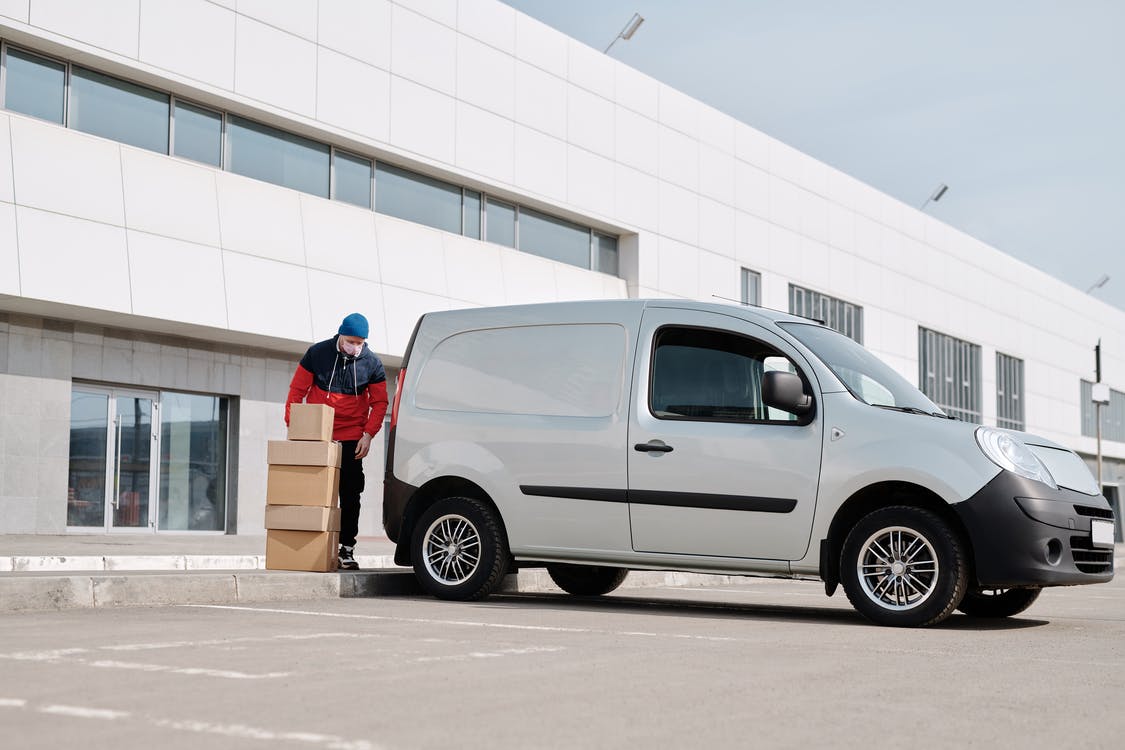
Van transport seems to be a good market niche for two Split students / Source: Pexels
The young duo from Split have been friends for over 15 years and have always planned to start a joint business. They have had some plans before, but they were disrupted by an unpredictable situation that shocked the whole world.
For furniture moving and transport services with their van, they are available in Split-Dalmatia County every day, at any time.
With a well-designed promotional campaign on social networks, they managed to reach their first clients very quickly. As they say, there is always a need for relocation and removal services for old furniture and similar bulky waste, so they have found their place on the market.
Low prices and high effort
"Our work is much more than just taking out and bringing in furniture and driving a van. We spend an entire 8-hour workday devising ideas, creating ads and planning. As we create graphics, pictures, hand out flyers, or do all the marketing, time really flies by," says Mario.
During their average workday, they don't go home until they do everything they can. They want to leave a good impression, be as fast, efficient, and careful as possible, but also more affordable because offering lower prices for their services makes them acceptable. They're aware that many people are currently in a difficult financial situation, so they started their business by offering lower prices for their services.
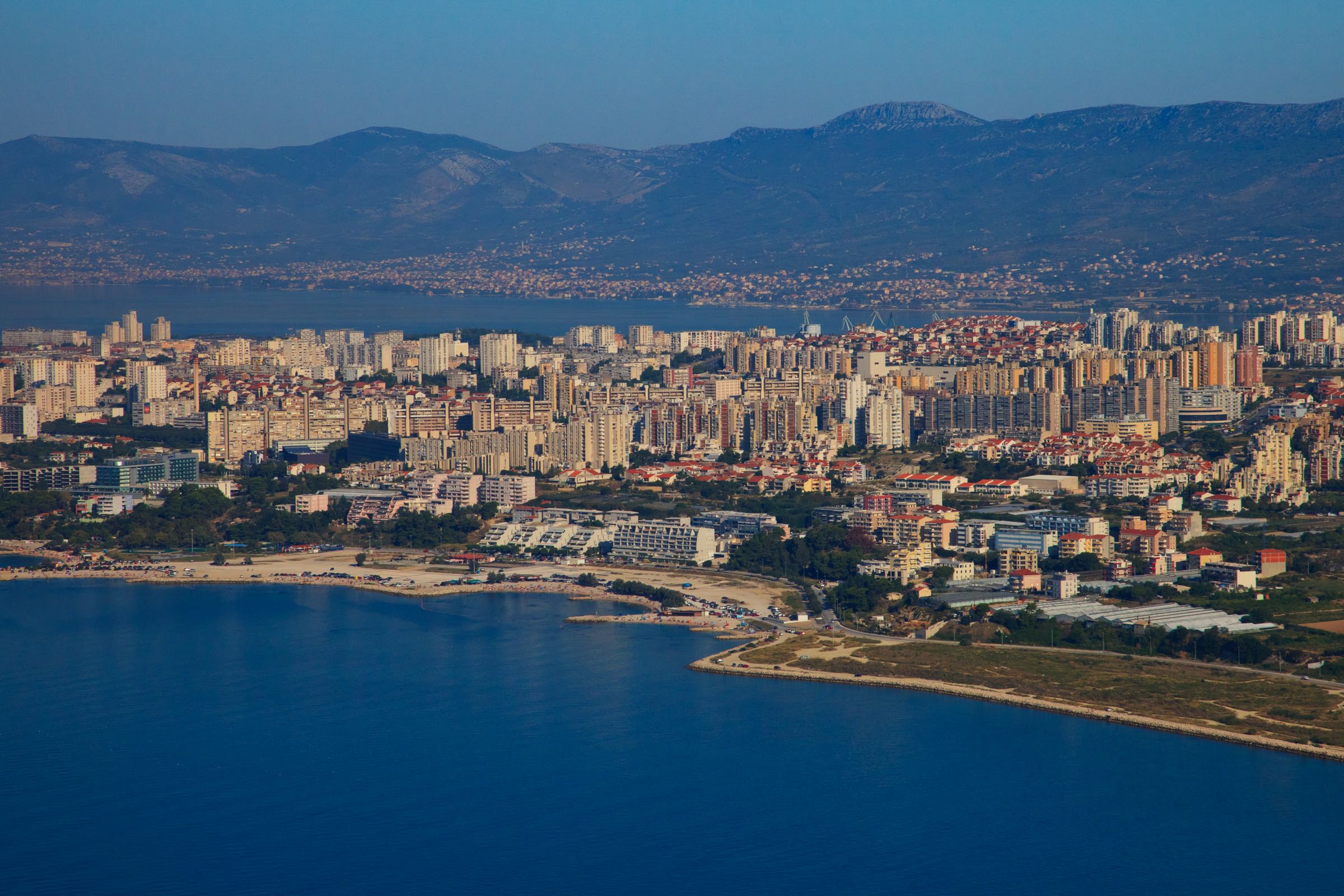
Their services are available in the Split-Dalmatia County / Copyright Romulić and Stojčić
This has proved successful for them so far. They earn enough for their needs and hope to be successful enough overtime to hire other students struggling with similar difficulties in finding jobs.
"After the physical work is done, we continue coordinating business for the next period, giving ideas and suggestions for new campaigns and designing a concept based on the mistakes we make," says Mario.
'You have to create opportunities for yourself'
On social networks, where they advertised from the very beginning, they received many supportive messages for their initiative. Their biggest reward, they say, is when clients promise to call them again and recommend them to a friend, neighbor, or godfather. And they are happy when they are greeted by kind and hospitable hosts and treated with some local delicacies.
Slowly but surely, they notice a positive business trend. People call them from Zagreb and even from abroad. Their next step is long-distance transport, outside Split-Dalmatia County, and in the future, they would like to try to organize transport outside the borders of Croatia.
"People are glad to see that young people are active and recognize that we fight to make it easier for our family, instead of sitting on a sofa and waiting for a job to fall from the sky. You can't cross your arms and expect opportunities. You have to create it yourself. Citizens appreciate that we are especially friendly to retirees for whom we have reduced transportation prices. We hope that you will hear more about us in the future if we succeed in other projects that we planned before the whole mess with the coronavirus," says Mario.
These two friends are a great example of how, with knowledge, resourcefulness, dedication, and hard work, it is possible to take control of your misfortunes and earn a few kunas in this unpredictable time.
For the latest travel info, bookmark our main travel info article, which is updated daily.
Read the Croatian Travel Update in your language - now available in 24 languages.
Share a Bedroom with a UNESCO World Heritage Site at Hotel Peristil in Split
January 27, 2021 - I have found strange things in my hotel rooms over the years, but nothing quite like at Hotel Peristil in Split - the outer wall of a Roman Emperor's palace.
It is a strange thing being a tourism blogger living in a tourism country.
The perspective is different.
What tourists see as a once in a lifetime experience are everyday experiences to the local resident. I first fully appreciated the difference over three years after I started the Total Hvar website in 2011. Several years later, I was invited by Karin Mimica of Gastronaut to join her foodie media club for a three-day tour of my adopted island. It was quite a trip, and this was only the first day. My perspective of Hvar changed forever that day, and I like to think it made me a more effective travel writer, as I had seen my island through tourist eyes.
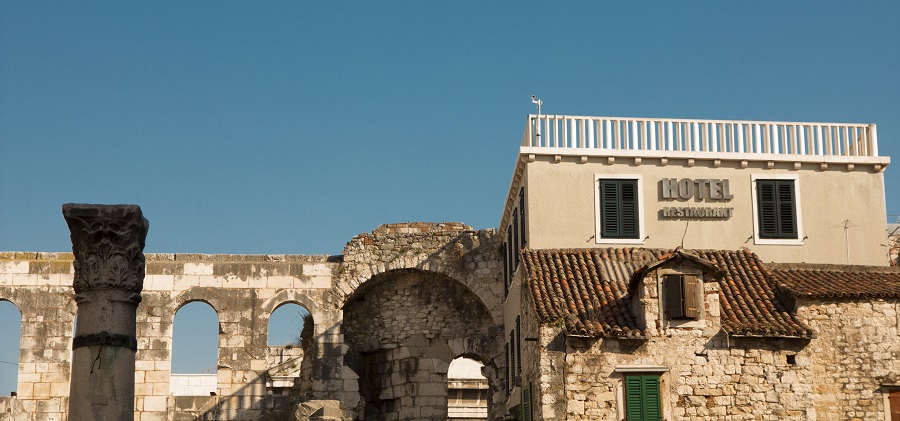
I have always had the same strange feeling about Diocletian's Palace in Split. For years, I didn't even know that it was a UNESCO World Heritage Site, such was the level of tourism promotion in the city a decade ago. In truth, especially in the evening in winter, I found the palace a little intimidating. There were few bars, everything was dark, and there were some parts best avoided.
The transformation in the last ten years has been a joy to watch, and today, Diocletian's Palace is one of the coolest places to hang out on the Croatian coast.
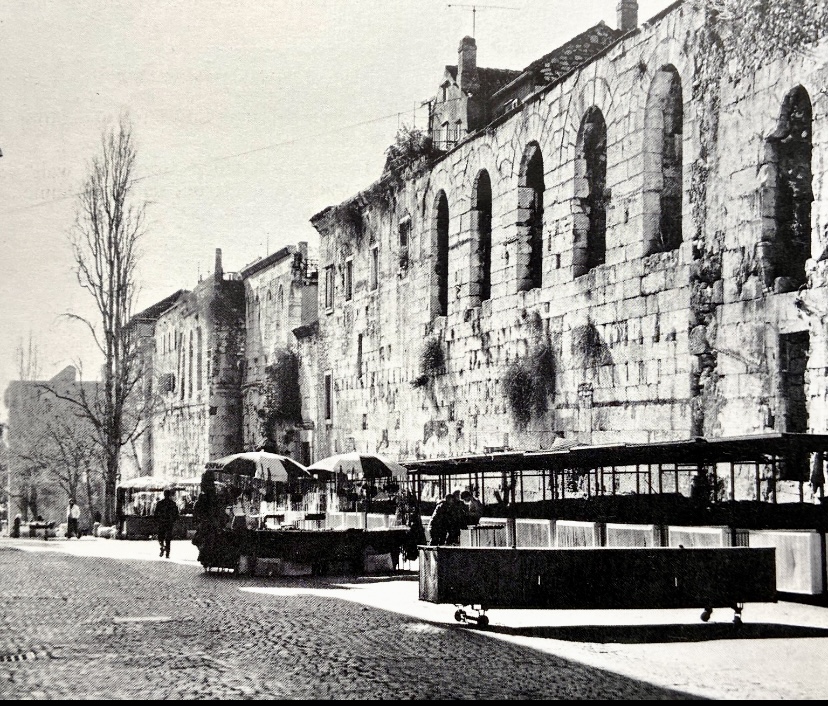
For years, I walked around the palace going about my business, sharing those historic alleys with an ever-increasing throng of tourists learning more about this Roman Emperor's incredible retirement home. I smiled often as I overheard a not-uncommon question at the end of a tour of Diocletian's Palace:
"But where is the actual palace? Can we visit that now?"
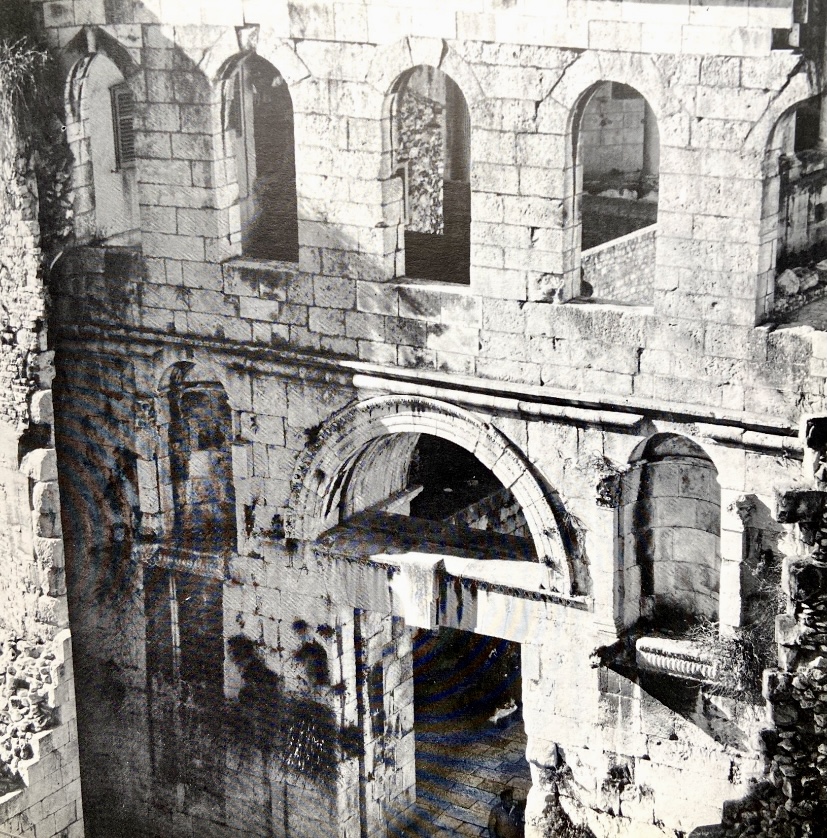
Thousands of years of history which you take totally for granted as a local, for it is with you every day. It was only when I finally did my own guided walking tour of the palace that I saw the destination - like Hvar before it - through tourist eyes.
And then, last autumn, I had a rather pleasant - and very private - rendezvous with 1,700 years of history in the most unlikely of places - my hotel bedroom.
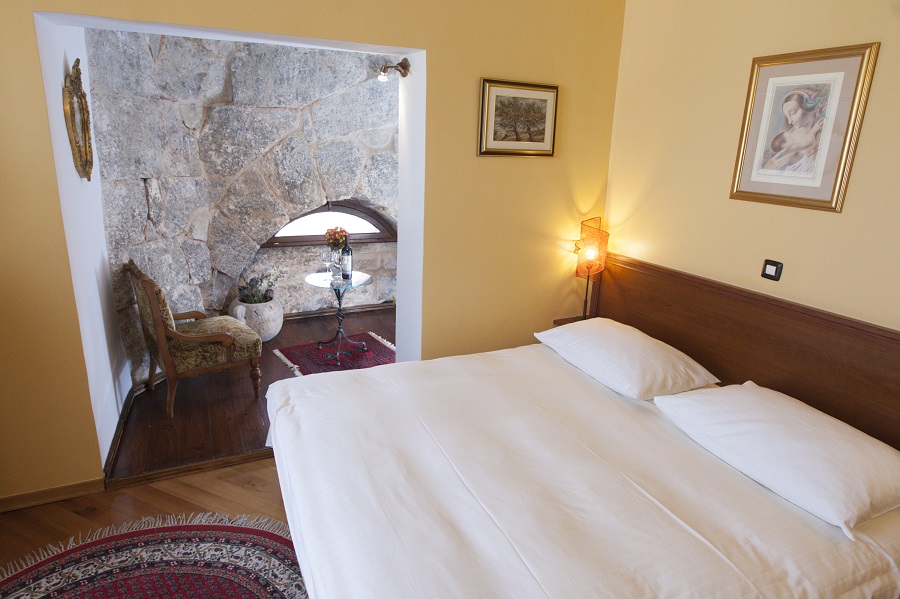
My normal Split pad was unavailable, and so I decided to check out a small hotel which had mildly fascinated me for years, but which I had never visited - Hotel Peristil. Just 12 rooms in all, the hotel is perched on one of the original outer walls of the original palace.
When I entered the room, something quite spectacular awaited. Although I had reserved a single, it seemed that I would be sharing my room after all - with an original Roman outer wall from Diocletian's Palace, which sat majestically near a delightful side room just off the bedroom.
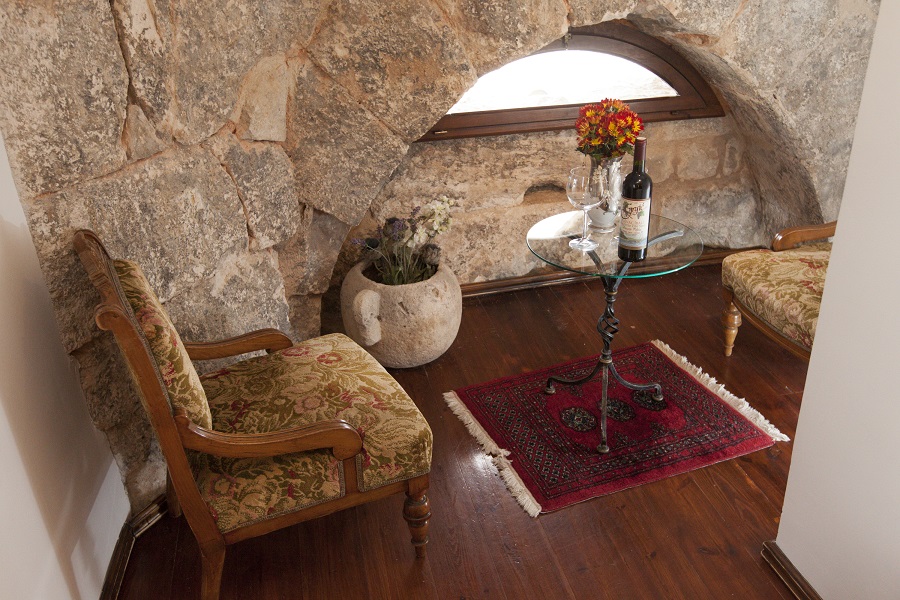
Here I was, just metres from every attraction in the palace, the ferry, the riva and the green market, so close to all the tourist throngs, and yet a world away.
Rather than dive into my laptop as I planned, I decided to take a break and savour the moment with a glass of wine (ok, three) sat in my temporary living room next to 1700 years of history. A very private moment of contemplation, as life in Split continued around me.
It is moments like that which - for me at least - make the greatest memories in travel.
Some time later, the bottle empty, I returned to work, but the memory of that private audience with history remains one my highlights of 2020.
You can learn more about Hotel Peristil here.
For the latest news from Split, follow the dedicated TCN section.
Flights to Croatia: Wizz Air Adds Another Split Route this Summer
January 26, 2021 - The latest news for flights to Croatia as Wizz Air adds another Split route in its summer flight schedule.
Croatian Aviation reports that only five days after it announced a new line from Gdansk to Split, Wizz Air has added another to Dalmatia's busiest airport.
Wizz Air, a Hungarian low-cost airline, launched another new route to Split Airport, specifically in this year's summer flight schedule.
Namely, from June 6, the Oslo - Split - Oslo line will be introduced, which will operate twice a week, on Thursdays and Sundays, departing in the evening from Split Airport.
Norwegian and SAS also connect Oslo and Split with direct flights in the summer flight schedule.
In its summer flight schedule, Wizz Air will offer over 15,000 available seats between Oslo and Split!
Wizz Air will operate A320 aircraft on the route, which has a capacity of 180 passengers in the fleet of this carrier. The line will work until the end of October (October 28, 2021), and the airline will perform 42 return flights on this route.
Tickets are on sale on the airline's official website from today.
Croatian Aviation reported last week that Gdansk - Split - Gdansk would operate from June 17 to mid-September, twice a week, in the evening on Thursdays and Sundays.
The new route between Gdansk and Split will be operated by A320 aircraft with a capacity of 180 seats in the Wizz Air fleet.
The airline has 26 return flights on sale on this new route, making more than 9,300 seats available between Split and Gdansk.
Split is the only destination of this well-known low-cost airline in the Republic of Croatia, for now. In the summer flight schedule, the airline will operate to Split on six international routes, two of which are new - Gdansk and Oslo.
For the latest travel info, bookmark our main travel info article, which is updated daily.
Read the Croatian Travel Update in your language - now available in 24 languages.
Brodosplit Will Build the World's Largest Electric-Powered Sailing Ship
January 24, 2021 - Brodosplit will build the world's largest electric-powered sailing ship, leaving no carbon footprint in the environment.
Slobodna Dalmacija writes that stemming from the electric-powered river tram, an idea borne by Željko Hederić and the team from Osijek's FERIT, the world's largest electric-powered sailing ship with three masts should bear fruit in Split.
Brodosplit will soon begin constructing a three-masted schooner, a completely eco-friendly ship that will be powered by electric motors, while the batteries will be charged by sailing, leaving no carbon footprint in the environment.
It is even more impressive that this is a project for developing a ship propulsion system from the IRI2 program, for which the European Union has co-financed 60 percent of the value. However, those responsible have not stated the amounts in question.
The project is lead by the DIV Group, which owns the Split shipyard, and partners from the scientific research community, including FERIT and Split FESB. Work on the project began almost a year ago - last February, and will last a total of three and a half years.
"Split has already made "Klara," a classic three-masted schooner, but they also wanted something more modern, and they wanted to improve the project. We, on the other hand, developed the "river tram" project at the faculty in Osijek, because we have the Drava. And you have the sea! Everything is based on the principle of using hydrokinetic energy," says Hederic.
Namely, water flows through a standing turbine and converts hydropower into electricity. In the case of this ship, the sea “stands,” and the sailboat goes, pushed by the force of the wind in the sails. Of course, the screw or propeller spins, creating electricity. The professor says that in this way - from wind energy, i.e., sails as a turbine that drives the ship - you can get four to six knots of the ship's relative speed, which gives torque to the rotation of the bolt like a generator turbine.
Thus, hydrokinetic recovery of wind energy into battery electricity.
"For example, the wind gives the ship energy for a speed of ten knots, and we reduce it to six knots and save the difference in the battery. I call it - plowing the sea. From our scientific ideas, engineers will perform a technical solution," points out the Osijek professor.
When it is not using sails, the ship will be powered by two electric motors, each with a power of 150 kilowatts. They will be powered by a system of batteries that are continuously charged from various sources. When it reaches a sailing speed of six knots, the ship will need only 60 kilowatts of power, which is a relatively imperceptible power for a vessel of 500 gross tons, explained Brodosplit.
The ship will be equipped with 30 tons of batteries, whose capacity, figuratively speaking, is like having 60 Tesla cars. More precisely, it has a total of a maximum of 2300 kilowatt-hours, which ensures more than 50 hours of cruising exclusively on stored electricity when there is no wind.
Due to navigation safety, the ship will have two diesel units that would be turned on only if needed but will be more likely to rust from non-use, they emphasized.
What will set the Split sailing ship apart from similar vessels is that the vessel will charge its batteries when sailing but in a very ingenious way. A system of the already mentioned ship propellers with variable pitch and special wing geometry will be used, which will - for sailing - serve as a hydro turbine.
Brodosplit explains that this "reversible screw" will charge the batteries in the lower deck.
All relevant information will be collected and supervised on the bridge, or command center. From meteorological data, so that the commander knows where the wind is most favorable, to all other ship systems and propulsion, electricity supply in batteries, engine operation, solar panels, wind farms, hot water, and energy consumption.
"All "revenues" and "expenditures" of energy on the ship will be managed and controlled from one place," said the Split shipyard.
Experts from Split FESB, led by Branko Klarin, work on the sailing system and its robotics, wind turbines, and photovoltaic panels. At the sailboat's bow and stern, two vertical wind turbines are planned to supply the ship with electricity while in port or at anchor.
A photovoltaic solar power plant will be installed on the roof of the superstructure. Klarin's team will address how to extract and store heat from a solar photovoltaic power plant by cooling the panels to be more efficient in producing electricity. Photovoltaic panels work most efficiently at a temperature of 20 degrees Celsius, but on their surface, on sunny days, it can be as high as 80 degrees, so excess heat can be used to heat water.
Thus, the sailboat will be supplied with electricity, heat, and water from entirely renewable sources: all the energy will be obtained without any carbon dioxide emissions.
"In short, there are no costs for fuel and power supply of propulsion machines, as well as all devices inside the ship, air conditioning, and kitchen," concludes Hederić, emphasizing that electric drive is three times more efficient than diesel.
To read more about lifestyle in Croatia, follow TCN's dedicated page.
Diocletian's Chest: Children's Project Recognized by World Federation of Tourist Guides
January 23, 2021 - City of Split project Diocletian's Chest, designed in cooperation with primary schools and the Association of Tourist Guides to raise awareness among the youngest about Split's cultural heritage and the importance of its preservation, received great recognition from the World Federation of Tourist Guides (WFTGA).
Slobodna Dalmacija reports that the project was recognized just in time for International Education Day, which is celebrated on January 24. The World Federation of Tourist Guides praised this project called "Children - the guardians of our heritage" with the great merit of the Croatian Association of Tourist Guides. It is an excellent example and desirable model to bring children closer to the importance of historical and cultural heritage through education. In addition, this international organization invites other countries to join the project and apply the same education model and presentation of historical heritage in their cities.
Diocletian's Chest has been held since 2012. It is attended by 1,700 students, more than 70 teachers from all primary schools in Split, school coordinators, and a large number of tourist guides. Children have the opportunity to tour the Palace with expert guidance, and in the second part of the project, they participate in a knowledge quiz and an exhibition of student works on the theme of Diocletian's Palace. The project envisages awarding prizes to the most successful schools. In this way, they learn how to respect and present the heritage and preserve the great historical and civilizational heritage of Split for centuries to come.
"The Split model of showing the youngest the significance of our vast and rich heritage has received great international recognition. The echoes of our efforts and efforts to preserve the historical heritage for generations to come through education have been in the focus of a large organization such as the World Federation of Tourist Guides, an associate member of the UN World Tourism Organization, and a member of UNESCO. And all this at a time when tourist guides are fighting for survival as well as the correct interpretation of cultural heritage and history in which, as always, I give them full support," said Split Mayor Andro Krstulović Opara.
The World Federation of Tourist Guides, based in Vienna, is an organization that brings together national associations from 80 countries worldwide and represents over 150 thousand guides.
To read more about lifestyle in Croatia, follow TCN's dedicated page.
Flights to Croatia: Eurowings Connects Four Croatian Cities with Berlin Brandenburg in Summer
January 23, 2021 - The latest news for flights to Croatia Eurowings connects four Croatian cities with Berlin Brandenburg in summer.
Croatian Aviation reports that Rijeka, Zadar, Split, and Dubrovnik will have a direct line to Berlin's new airport this summer!
In its timetable for the upcoming summer season, Eurowings has announced these four routes as new. However, almost all of the above-mentioned Croatian airports previously had a connection to Berlin Tegel Airport. Since the airport is closed, traffic to Croatia will be transferred to the new airport, and for the first time, four Croatian cities will be directly connected to the new Berlin Brandenburg Airport.
The first line will be the Berlin - Split - Berlin line, before the Easter holiday. The flight will mark the start of the season on Saturday, April 3. The airline plans to operate on this route until October 30, every Saturday, and from June 1, the number of weekly flights will increase to two. Namely, an additional flight is introduced on Tuesdays. In this period, Eurowings will operate over 50 return flights between Split and Berlin and offer more than 17,500 seats in both directions. A319 and A320 aircraft have been announced on the route and all other routes to Croatia.
The Berlin - Dubrovnik - Berlin line will start operating on May 9 and run until the end of the summer flight schedule, October 24. One flight per week is available every Sunday, so Eurowings will offer around 8,200 seats on this line during the season.
The Berlin - Rijeka - Berlin line will be in operation from May 15 to October 30, also once a week, on Saturdays. Twenty-six return flights are planned, with Eurowings currently offering more than 8,500 seats between Berlin and Kvarner.
The Berlin - Zadar - Berlin line has been announced from May 22 to October 30 and will also operate on Saturdays once a week. The 25 announced return flights guarantee over 8,200 seats in both directions.
Eurowings will offer over 43,000 seats between Croatian airports and Berlin in the 2021 summer flight schedule.
Recall that in the summer of 2019, Eurowings operated from Berlin (ZL Tegel) to almost all airports in Croatia. In the summer season of 2020, only the Berlin-Split-Berlin route operated briefly. According to current announcements, Croatian airports will again be directly connected to the new Berlin Brandenburg Airport.
The airline currently offers cheap tickets on routes from Croatia to Berlin, starting from 50 euros, with all prices on the official Eurowings website.
For the latest travel info, bookmark our main travel info article, which is updated daily.
Read the Croatian Travel Update in your language - now available in 24 languages.
Join the Total Croatia Travel INFO Viber community.
PHOTOS: New Multipurpose Hall in Split Named After Split Composer Ivo Tijardović
January 22, 2021 - A new multipurpose hall in Split will bear the name 'Ivo Tijardović' after the famous Split composer.
Final preparations are underway for the technical inspection of the new multipurpose hall on Trg Hrvatske bratske zajednice, for which a permit should be issued at the end of February.
Recall that the reconstruction works worth HRK 5.6 million were carried out by the company Tekton gradnja d.o.o. according to the project solution of the company Super ured d.o.o., while the supervision was done by Meritum inženjering d.o.o. The Ministry of Culture set aside HRK 500,000 for the investment, and the City of Split provided other funds.
In 2002, the hall saw rough construction works. In February 2020, 18 years later, work began on bringing it to its purpose - a new cultural center in the city of Split. It will soon hold cinema screenings, theater performances, cultural - music events, conferences, and congresses. The auditorium has 155 seats and two seats for people with disabilities. It is also located where the cult Kino Split operated in the past.
Slobodna Dalmacija reports that in the outer part of the hall, the courtyard, there is still some of the garden of the former Kino Split, as well as the hall where schoolchildren and high school students listened to their first classical music concerts at the then "Musical Youth", and where renowned musical names were B. Papandopulo, S. Bomabardeli, and V. Lesić.
In that hall and on that stage, Split HNK held performances after the theater building was destroyed in a fire in 1970 - until it was rebuilt in 1979. Kino Split was then one of four in the city, along with "Bačvice", "Tesla," and the Navy Club on the West Coast, which - as a cultural phenomenon - was written about in 1957 by a French journalist who moved to Split, Madeleine Epron Denegri.
She wrote for the Paris weekly "Cinematographie Francaise" about screenings in the garden under the clear summer sky, and that Split had such a cinema before Zagreb. Her article also revealed that the then-popular film "East of Eden" with James Dean was watched by 14,441 Split citizens there!
In addition to the hall's space, the reconstruction also includes ancillary rooms, dressing rooms, sanitary rooms, and other rooms for the needs of stage staff. The hall access is adapted for people with disabilities and people with reduced mobility by installing two ramps on the stairs. This hall will be managed by the cultural institution Hrvatski dom Split - concert hall, which also operates the newly renovated concert hall on Tončićeva Street.
This new stage will soon open its doors to citizens, following the improved epidemiological measures, and thus revive the city's cultural scene. When it is open to the public, it will bear the name of the great Split composer Ivo Tijardović.
To read more about lifestyle in Croatia, follow TCN's dedicated page.
Nearly 30% of KBC Split Employees Vaccinated: "An Outstanding Response!"
January 20, 2021 - Nearly 30% of KBC Split employees have received the COVID-19 vaccine, which is an outstanding response.
Dalmatinski Portal reports that Dr. Ante Punda, President of the Expert Council of KBC Split, presented how many hospital employees were vaccinated against COVID-19.
"We had our regular session today, and I can state with satisfaction that all members have been vaccinated, apart from the ones who recently recovered from Covid. They will be vaccinated in the coming period. I thank the ministry and the media for the promotion. KBC is aware of the responsibility; to think of others, we have to think of ourselves.
Thanks to our epidemiological service that conducts vaccination, the response of employees is high. You have seen that epidemiological measures have yielded results. If we are responsible, we will reach the goal of having fewer cases. In three weeks, we vaccinated 1,082 employees, 435 doctors, and 318 nurses; the rest is support staff, our technicians, and laboratory technicians. Now comes the second phase of vaccination. That's about 28.5 percent. All KBC employees are invited. I think that’s a satisfactory figure for the first three weeks. We made the most of the vaccine. That is a respectable figure. We expect that the number of vaccinated will increase as more vaccine doses arrive," said Dr. Punda.
The director of KBC Split, Julija Meštrović, is delighted with the number of vaccinated employees.
"You know how it was said that interest in vaccination at this hospital was minimal. All the vaccine was used. First, those who work in the Covid center were vaccinated. It can't get any better than this. It was done quickly. The response is the best possible. Everyone we could vaccinate was vaccinated. Motivation is very high. The current situation shows this. I don’t know if some don’t want to get vaccinated. What has been achieved is a truly remarkable result. The situation in Croatia is excellent; we must continue to adhere to ongoing measures. The number of hospitalized is decreasing, and because of that, it is becoming easier to work. We have the opportunity to dedicate ourselves to other patients, which is very good," said Dr. Meštrović.
To read more about COVID-19 in Croatia, follow TCN's dedicated page.
2021 Split Marathon to be Held in September
January 19, 2021 - The 2021 Split Marathon will not be held in February like in previous years, but in late September.
Dalmacija Danas reports that one major sporting event that has gathered several thousand runners in the city of Split in recent years is the Split Marathon. The event is usually held in February, and last year, for example, it was held on February 23.
The second marathon in the newer edition, which the organizers are preparing in this calendar year, has now been moved to autumn, more precisely to September 26, 2021. The starting time will be "at dawn", i.e., at 7:30 am, so the participants can avoid running through unbearable heat.
The new date was revealed by Kristijan Sindik, the president of the Organizing Committee, on the official Split Marathon Facebook page.
The marathon itself gathers 800 competitors and runs a little more than 42 kilometers, while the half marathon sees around 2500 runners. It is important to include the recreationists, children, organizers, track security, police, and other city services, gathering around 4000 people in one place.
The Split Marathon is an event presented by the city for some time to position itself as a sports and tourist destination for many international competitors who have the opportunity to run the track and enjoy the beauties of Split and the surrounding areas.
The Split marathon is the third-largest in the region, with only Ljubljana and Belgrade ahead, which is to be expected considering the number of inhabitants. Split, however, is said to be the best organized.
The Split Marathon event saw a record number of participants in 2020, or over 4,000, who ran on the Marathon and Half Marathon routes below.
The Split Marathon route:
Route: Obala Hrvatskog narodnog preporoda – Marmontova ulica – Ulica kralja Tomislava – Zagrebačka ulica – Manuška poljana – Livanjska – Ulica Domovinskog rata – ulica Zbora narodne garde – Ulica Domovinskog rata – Solinska ulica – Splitska ulica – Krešimirova ulica – Obala pomoraca – Krešimirova ulica – Splitska ulica – Solinska ulica – Hercegovačka ulica – Put Supavla – Lora – Zrinsko Frankopanska – Osmih mediteranskih igara – Stadion Poljud – Osmih mediteranskih igara – ZrInsko Frankopanska – Ulica 7 Kaštela – Matoševa ulica – Šetalište Marina Tartaglie – Šetalište Ivana Meštrovića – Obala kneza Branimira – Trumbićeva obala – Obala Hrvatskog narodnog preporoda – Obala Lazareta – Obala kneza Domagoja – HŽ Bačvice – Plaža Bačvice – Šetalište Petra Preradovića – Put Firula – Spinčićeva ulica – Šetalište Kalafata – Šetalište pape Ivana Pavla II – OKRET – Šetalište pape Ivana Pavla II – Šetalište Kalafata – Spinčićeva ulica – Put Firula – Šetalište Petra Preradovića – Hatzeov perivoj – Ulica Matije Gupca – Prilaz braće Kaliterna – Plaža Bačvice – HŽ Bačvice – Obala kneza Domagoja – Obala Lazareta – Hrvojeva ulica – Ulica kralja Tomislava – Marmontova ulica – Obala Hrvatskog narodnog preporoda – FINISH
The 20th edition of Split Half Marathon ran on an AIMS certified track:
Route: Obala Hrvatskog narodnog preporoda – Marmontova ulica – Ulica kralja Tomislava – Zagrebačka ulica -Manuška poljana – Livanjska – Ulica Domovinskog rata – ulica Zbora narodne garde – Ulica Domovinskog rata – Stinice ulica – Put Supavla – Lora – Zrinsko Frankopanska – Osmih mediteranskih igara – Stadion Poljud – Osmih mediteranskih igara – Zrinsko Frankopanska – Ulica 7 Kaštela – Matoševa ulica – Šetalište Marina Tartaglie – Šetalište Ivana Meštrovića – Obala kneza Branimira – Trumbićeva obala – Obala Hrvatskog narodnog preporoda – FINISH
To read more about sport in Croatia, follow TCN’s dedicated page.
Split Promet Introduces E-Ticketing System Worth 23 Million Kuna
January 17, 2021 - A contract worth 23 million kuna was signed in Split, which will enable the Split city carrier Promet to procure an e-ticketing system, which will improve city transport.
As Hina reports, the Promet Director Miroslav Delić pointed out that the e-ticketing system in Split will improve public transport availability, increase passenger information, improve the data management system, and raise citizens' awareness of the benefits of using public transport.
"There is no similar system in Croatia. A reliable public transport service is an absolute imperative of the project," Delić said. The deadline for implementing the system is 12 months.
The mayor of Split, Andro Krstulović Opara, said that out of the 23 million kuna intended for that system, 12 million was from the EU's ITU mechanism.
"This is not just a confirmation that our city carrier Promet has finally become a healthy and modern company. This is an additional confirmation that the application of smart solutions, such as the e-ticketing system, has strengthened the status of Split as a smart city," said Krstulović Opara.
According to him, behind this project, there's a lot of work of city services and people from Promet - a company that, as he said, "deeply restructured and modernized through a major renewal of the vehicle fleet."
"By using smart solutions and exceptional technological innovations, Split becomes a city of pleasant living for its citizens and all those who come to visit it. We have shown that, as a city administration, we can attract large funds and strategically consider the development of Split," said the mayor.
As he pointed out, the City Administration's expert services, together with partners, have attracted more than 300 million kuna from the ITU mechanism in the past four years for the urban agglomeration of Split within the Operational Program "Competitiveness and Cohesion."
To read more about lifestyle in Croatia, follow TCN's dedicated page.


